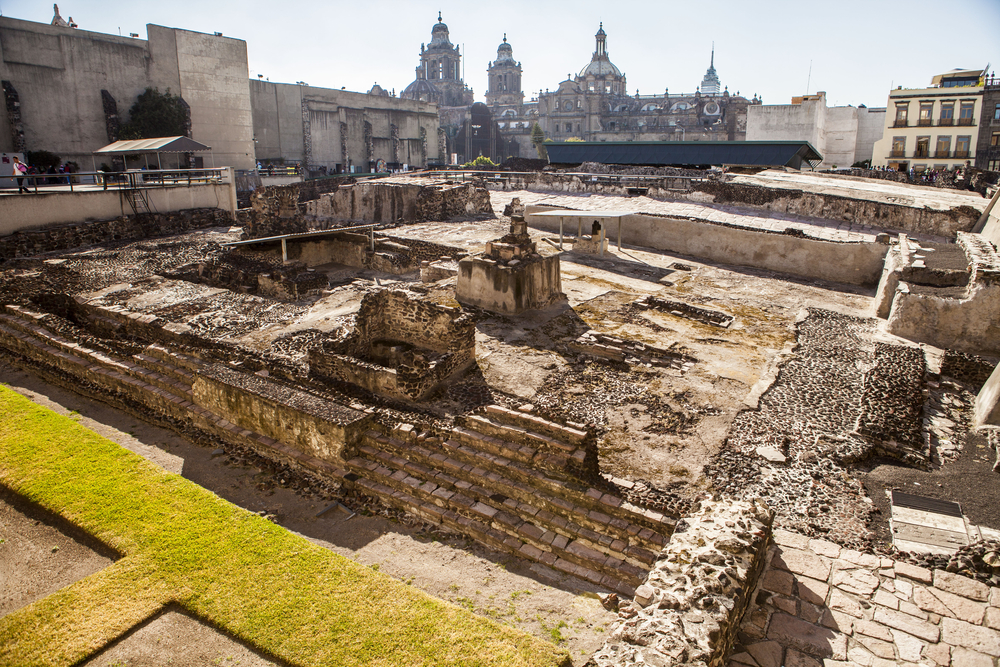Stunning eagle sculpture uncovered at sacred Aztec temple in Mexico
It is around 600 years old.

A striking 600-year-old Aztec sculpture depicting a golden eagle has been uncovered in an ancient temple in Mexico, archaeologists with Mexico's National Institute of Anthropology and History (INAH) announced Monday (Jan. 25).
The eagle, which measures 41.7 inches by 27.6 inches (106 by 70 centimeters), is the largest bas-relief sculpture ever found at the temple.
The eagle was carved into the floor of a structure at the foot of Templo Mayor — the iconic pyramid-shaped temple that was built at the heart of the ancient Aztec capital city of Tenochtitlán and is now in modern-day Mexico City.
Artists created the bas-relief — a type of sculpture with raised images carved out of a stone background — in the mid-15th century during the reign of Moctezuma I.
Archaeologists from INAH discovered the carving in February 2020 as a part of the ninth season of the Templo Mayor Project, an ongoing excavation of the sacred site.
Related: Top 10 ancient capitals
"It is a very beautiful piece that shows the great secrets that the Templo Mayor of Mexico Tenochtitlán has yet to reveal to us," Alejandra Frausto Guerrero, Mexico's secretary of culture, said in a statement. "Thanks to their [the archaeologists'] effort and dedication, we can continue to recover our history and our memory."
Get the world’s most fascinating discoveries delivered straight to your inbox.
A sacred location
Templo Mayor, also known as the Great Temple, was a massive, pyramid-shaped structure that stood in the center of Tenochtitlán and was the heart of Aztec religion and culture. At its summit were two chapels dedicated to Huitzilopochtli — the god of the sun and war and also patron of the city — and the rain god Tlāloc. The temple was one of 78 structures that made up the sacred precinct of Tenochitlán.
"For the Aztecs, the Templo Mayor lay at the heart of the physical, mythical and spiritual universes," Caroline Dodds Pennock, an Aztec historian at the University of Sheffield in England, told Live Science in an email.
The Aztec leader Itzcoatl, who reigned between 1427 and 1440, first built the temple at the start of the 15th century. Subsequent rulers Moctezuma I (who reigned from 1440 to 1469) and Ahuítzotl (who reigned from 1486 to 1502) also made significant contributions to the temple, often building over earlier structures.
The bas-relief eagle is carved into the floor of one of the structures next to Templo Mayor and had been covered by another floor built on top of it during Ahuítzotl’s reign.
"That is why it has a good state of conservation," Rodolfo Aguilar Tapia, an archaeologist at INAH who led the investigation, said in the statement. "It is an element that was never seen by the Spanish," he said.
Today, the striking eagle sculpture lies beneath the intersection of two streets in Mexico City. However, when it was built, the structure would have sat at the base of the southern slope of Templo Mayor. It would also have been on the central axis — a line linking the chapel of Huitzilopochtli at the summit of Templo Mayor and a giant statue of his sister, the goddess Coyolxauhqui, down below.
Eagle symbology
The golden eagle (Aquila chrysaetos) — also known as an "itzcuauhtli," or obsidian eagle, in the Nahuatl language spoken by Indigenous people in central Mexico — was an important symbol in Aztec culture.
"The eagle was a sacred creature in Aztec thought, believed to have been present at the birth of the sun (hence, the blackened 'singed' wing tips) and was the symbol of one of the elite warrior orders in Aztec culture," Pennock said.
The bird of prey was also frequently linked with Huitzilopochtli, and the positioning of the bas-relief may echo an important myth surrounding the god.
"According to the Aztecs' mythical history, Huitzilopochtli had vanquished his sister Coyolxauhqui and thrown her down a mountain, where she fell into pieces," Pennock said. "This history was repeated through human sacrifice on the Templo Mayor, as the bodies of victims were thrown down the steps."
Sculpting the eagle at the foot of Templo Mayor near the statue of Coyolxauhqui was probably a reference to both this story and the very real human sacrifices carried out there, Pennock said.
The bas-relief resembles an image of a golden eagle in the Codex Borgia, a famous Aztec manuscript dating back to the 16th century. Just as in the Codex Borgia, the newly discovered eagle's feathers look like sacrificial knives, according to the researchers.
"The Templo Mayor Project continues to shed remarkable insights on Aztec culture," Pennock said. "This eagle adds another layer to our understanding of the ways in which the Aztecs saw their mythical history as at the heart of their belief and ritual."
Originally published on Live Science.

Harry is a U.K.-based senior staff writer at Live Science. He studied marine biology at the University of Exeter before training to become a journalist. He covers a wide range of topics including space exploration, planetary science, space weather, climate change, animal behavior and paleontology. His recent work on the solar maximum won "best space submission" at the 2024 Aerospace Media Awards and was shortlisted in the "top scoop" category at the NCTJ Awards for Excellence in 2023. He also writes Live Science's weekly Earth from space series.




